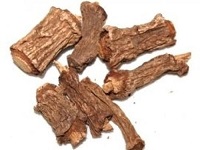In vitro antibacterial activity on human pathogenic bacteria and larvicidal effect of root from Hemidesmus indicus (Linn.) on Culex qinquifasciatus
Keywords:
Hemidesmus indicus, antibacterial, larvicidal activity, Culex quinquefasciatusAbstract
The present study was undertaken to evaluate the effect of extraction from Hemidesmus indicus roots on five different solvents activity against the pathogenic and non-pathogenic organisms also larvae of the Culex qinquifasciatus mosquito. H. indicus (L.) is one of the plants used in Ayurveda for several remedies it belongs to the family Asclepiadaceae. The experimental roots were tested for their phytochemical constituents and antimicrobial activity against 15 human pathogenic microorganisms using standard disc diffusion method. Moreover, the methanol and petroleum ether extracts were active against most of the tested organisms as they showed potential phytochemical constituents. The antimicrobial activities of the extracts were compared with their respective reference antibiotics as minimum inhibitory concentrations (MICs). Apart from petroleum ether, all other solvent extracts such as ethanol, methanol, chloroform and aqueous extract showed significant results. Among the 12 bacterial species maximum inhibition zone was 16.00±0.18, 10.65±0.19 and 16.3±0.20 observed the following bacteria such as E.coli, P. mirabilis and S. typhimurium respectively. The larvicidal effect of aqueous extracts of H. indicus roots were tested against Culex quinquefasciatus larvae at the concentrations of 1, 2, 3, 4 and 5% upto three days. Larval mortality was 100% with the use of 5% concentration of root aqueous extract after 2 days was observed. It is suggested that the aqueous extract of Hemidesmus indicus can be used as natural insecticide for mosquito control.
References
Anoop A, Jegadeesan M, Gowrishankar R.
Antimicrobial activity of Hemidesmus indicus
var. indicus against human isolates of
Helicobacter pylori. Nat. Prod. Sci. 2003;9: 1-3.
Anoop A. A review on lndian saraparilla
Hemidesmus indicus (L.) R. Br. J. Biol. Sci.
; 8:1-12.
Anoop A, Jegadeesan M. Biochemical studies
on the anti-ulcerogenic potential of
Hemidesmus indicus R.Br. var. indicus, Journal
of Ethnopharmacology.
; 84 (2-3):149-156.
Atal CK, Sharma ML, Kaul A, Khajuria A.
Immunomodulating agents of plant origin. I:
Preliminary Screening. J. Ethanopharmacol.
;18:133-141.
Balasubramanian P, Prasad NS. Medicinal
plants among the Irulars of Attapady and
Boluvampatti Forests in the Niligiri Biosphere
Reserve. In: Ethanobotany in South Asia,
Maheswari, J.K. (1996 Ed.) Scientific
Publishers, Jodhpur, India.
Chacha M, Bojase-Moleta G, Majinda RRT
Antimirobial and radical scavenging flavonoids
from the stem wood of Erythrina latissima.
Phytochemistry. 2005;66:99–104.
Chitravadivu C, Bhoopathi M., Balakrishnan
Balakrishnan VT, Ellavazhalagan T, Jeyakumar
S. Antimicrobial activity of laehiums prepared
by herbal venders south India. Am. Eurasian J.
Sci. Res. 2009;4:142-147.
Das S, Devaraj SN. Glycosides derived from
Hemidesmus indicius R. Br. Root inhibit
adherence of Salmonella typhimurium to host
cells: Receptor mimicry. Phytother. Res.
;20: 784-793.
Das S, Prakash R, Devaraj SN. Antidiarrhoeal
effects of methanolic root extract of
Hemidesmus indicus (Indian sarsaparilla), an in
vitro and in vivo study. Indian J Exp Biol.
;41:363–66.
David JP, Rey D, Meyran JC, Marigo G.
Involvement of lignin like compounds in
toxicity of dietary alder leaf litter against
mosquito larvae. J. Chem. Ecol. 2000;27:161-
Divysree S, Cherupally KKN. Amelioration of
cisplatin-induced nephrotoxicity by extracts of
Hemidesmus indicus and Acorus calamus.
Pharma. Biol. 2010;48:290-295.
Aqil F, Ahmad I, Owais M. Evaluation of antimethicillin-resistant Staphylococcus aureus
(MRSA) activity and synergy of some bioactive
plant extracts. Biotechnol. J. 2006;1:1093-1102.
Francois G, Van Looveren M, Timperman G,
Chimanuka B, AkeAssi L, Holenz J,
Bringmann G. Larvicidal activity of the
naphthylisoquinoline alkaloid dioncophylline-A
against the malaria vector Anopheles stephensi.
J. Ethnopharmacol. 1996;54: 125-130.
Gopiesh KV, Kannabiran K. Larvicidal effect
of Hemidesmus indicus, Gymnema sylvestre,
and Eclipta prostrata against Culex
qinquifaciatus mosquito larvae. African J. of
Biotechnol. 2007;6(3): 307- 311.
Kirthikar KR, Basu BD. Indian medicinal
plants. 1-4. 1980. Bishen Singh Mahendra Pal
Singh, Dehredun, India.
Kokate CK,. Practical Pharmacognosy. 1999.
Vallabh Prakashan, New Delhi, pp:
- 125.
Lee SE. Mosquito larvicidal activity of
pipernonaline, A piperidine alkaloid derived
from long pepper, Piper longum. J. Am. Mosq.
Control Assoc. 2000;16:245-247.
Gayathri M, Kannabiran K. Antimicrobial
activity of Hemidesmus indicus, Ficus
bengalensis and Pterocarpus marsupium roxb.
Indian J. Pharm. Sci., 2009;71:578-581.
Malhotra SK, Murthy S. Some useful and
medicinal plants of Chandrapur district
(Maharastra state). Bull. Bot. Surv. India,
;15: 13- 21.
Mandal P, Sinha BSP, Mandal NC.
Antimicrobial activity of saponins from Acacia
auriculiformis. Fitoterpia. 2005;76:462–65.
Massoud AM, Labib IM, Rady M. Biochemical
changes of Culex pipiens larvae treated with oil
and oleo-resin extracts of Myrrh Commiphora
molmol. J. Egypt Soc. Parasitol. 2001;31:517-
Pelah D, Abramovich Z, Markus A, Wiesman
Z. The uses of commercial saponin from
Quillaja saponaria bark as a natural larvicidal
agent against Aedes aegypti and Culex pipiens.
J. Ethnopharmacol., 1976;81: 407-409.
Ray PG, Majumdar SK. Antimicrobial activity
of some Indian plants. Econ. Bot. 2002;30:
-320.
Das S, Devaraj SN. Anti-enterobacterial
activity of Hemidesmus indicus R. Br. root
extract. Phytother. Res. 2006; 20: 416-421.
Sieradzki K, Roberts RB, Haber SW, Tomasz
A. The development of vancomycin resistence
in a patient with resistance in a patient with
methicillin resistant Staphylococcus aureus
infection. N. Engl. J. Med. 1999;340: 517- 523.
Slobodnikov L, Kost'alova D, Labudova D,
Kotulova D, Kettmann V. Antimicrobial
activity of Mahonia aquifolium crude extract
and its major isolated alkaloids. Phytother. Res,
;18: 674–676.
Wiesman Z, Chapagain BP. Larvicidal activity
of saponins containing extracts and fractions of
fruit mesocarp of Balanites aegyptica.
Fitoterapia. 2006;77: 420-424.



